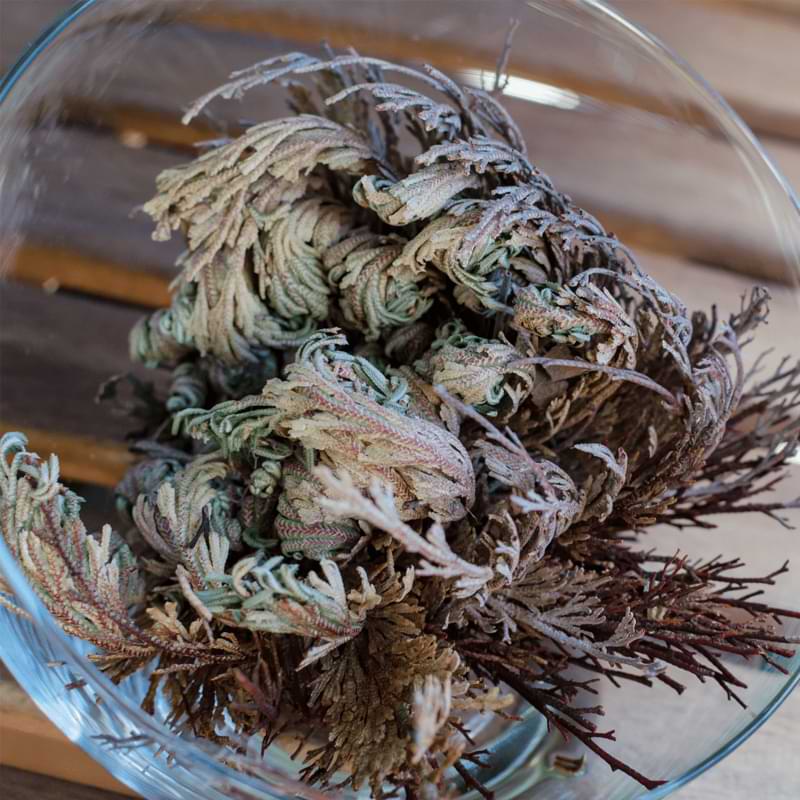Table of Contents
Care for Rose of Jericho
Few houseplants inspire as much legend as the Rose of Jericho, which gets the name the resurrection plant from its amazing ability to “come back to life” after completely drying out.
While drying out may sound like a recipe for disaster, it’s actually the secret to this plant’s success. Rose of Jericho is a type of moss native to desert regions where water is scarce, so this plant can completely dry out, curl up over itself, and blow around like a tumbleweed until it finds water. When it finds a water source, it unfurls to reveal gorgeous green fern-like fronds. Once it exhausts its water supply, it dries out again and blows on to the next watering hole.
Pretty cool!
Ready for your own Rose of Jericho? The good news is, it’s hard to truly kill a Rose of Jericho. You can let it dry out completely and it will be good as new when you put it in water again. If you’ve ever had issues with mindful plant watering, then this is the plant for you!
These plants are actually very long-lived and have even been passed down generations in families!

Your Guide to Rose of Jericho Care
The biggest challenge in growing or reviving a Rose of Jericho is watering. While the plant can survive with almost no water if necessary, it can rot if overwatered.
So what’s the perfect amount of water for your Rose of Jericho? What’s the best way to water?
It’s easier than you think!
Watering
A big part of watering your Rose of Jericho is your pot setup.
Step 1: To “plant” your Rose of Jericho, select a shallow dish with no drainage holes and fill with pebbles or gravel, leaving an inch or two of space at the top. (By the way, we’ve seen people revive these in a dish of water without the pebbles. We just find that the pebbles make a nice base and give the plant something to sit on.)
Step 2: Fill the dish with water until the pebbles are just submerged.
Note: Chlorine and other chemicals in tap water can damage your Rose of Jericho (and other houseplants too), so leave the water out overnight before adding to your dish, or leave in the dish overnight before adding the plant. This will allow the chlorine to dissipate and leave behind clean, pure water for your plant.
Step 3: Place your dried Rose of Jericho on top of the water so that the roots are submerged. The plant should start blooming within a few hours.
Now that you’re set up, how do you keep it happy? Well, it’s all in your schedule.
Schedule
Change the water for your Rose of Jericho every day to keep it clean. (If you skip a day here and there, you’ll be okay.) Simply set out some fresh water every night, then in the morning, drain the dish and add the fresh water.
The trick to preventing overwatering and root rot in Rose of Jericho is to give it water-free rests. Pick one day a week to drain the dish completely and let your plant rest. You can leave it in the dry dish or take it out. Simple!
Every month, give your Rose of Jericho a week without water to dry out a little bit. Choose the same week every month to make this easy. Simply drain the dish and leave the plant on the pebbles, or remove the plant completely and put it in a darker place.
For a sample watering schedule, check out our Rose of Jericho watering guide here.
This is also the easiest plant to care for if you leave on vacation. Simply take the plant out of the water, put it in a dark, dry place, and it will dry up until you get home when you can revive it! If you can never seem to find plant sitters for your vacations, this is the plant for you!
Planting
When you purchase your Rose of Jericho, it will look like a brown, dried-up ball of moss, which is basically what it is.
It does have roots, but they don’t actually need to attach, so you don’t need soil (it’s more like hydroponics).
To “plant,” fill a small pot or bowl without drainage holes (first time you’ve heard that, right?) with pebbles or gravel, and fill with water until the pebbles are just barely submerged. Perch your Rose of Jericho on top so that the roots touch the water. Place in indirect light (like on a countertop in a sunny kitchen) and watch the magic happen!
Tip: Use distilled water or let tap water sit out overnight for the chlorine and any other chemicals to evaporate before adding to your plant.
Change the water every day or so and give it a water-free rest day each week. Every couple of weeks, let the plant dry out completely.
If you’d like, you can put a false Rose of Jericho in soil after it’s been in water for a while and starts to form roots. Keep the soil fairly moist. However, these can get pretty big when planted in soil, so you may or may not want to do this.
Temperature
Don’t let the plant get too hot or too cold. Most room temperatures are fine, but watch for drafts and vents. Although a Rose of Jericho is native to desert environments, it can still be sensitive to extreme fluctuations in temperature.
Light
A Rose of Jericho will thrive in good light, but if it curls up in low light (or if you put it away in a closet for safekeeping over the winter), you can always revive it!
Pruning
Rose of Jericho doesn’t really need pruning, but you can use clean scissors to remove dead tips that don’t revive when the plant is fully hydrated. This will help keep it nice and pretty!
Rose of Jericho FAQ
FAQ: How long does it take for a Rose of Jericho to open?
If placed in lukewarm water, your Rose of Jericho should open in about 4 hours, though it might not open to its full capacity for a few days.
FAQ: Is Rose of Jericho toxic?
It’s hard to find a definitive answer since this plant is relatively new on the houseplant scene. However, as a member of the spikemoss family, Selaginella lepidophylla (false Rose of Jericho, the common one you’re most likely to find) may be toxic to cats, so it’s best to play it safe and keep your Rose of Jericho out of reach of your furry friends—or choose a different plant altogether.
FAQ: Where do you buy Rose of Jericho?
Check out our article How to Buy a Rose of Jericho Online for all the info you’ll need to add one of these awesome plants to your houseplant collection.
Give it a try!
Providing spontaneous beauty with a rich history, Rose of Jericho is an eye-catching centerpiece and a great conversation-starter. If you want a magical experience with a hard-to-kill plant, give Rose of Jericho a try!
Check out these houseplant resources:
The Last Houseplant Book You Will Ever Need




